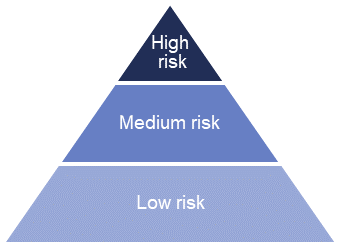Population Segmentation and Risk Stratification
Population Segmentation
Population Segmentation is the process of dividing a population into groups based on identified criteria to meet the needs of each group. Population Segmentation groups together individuals in the population with similar characteristics.
In Cwm Taf Morgannwg, the population is grouped using data on health care utilisation and comorbidities. As shown in the figure below, there are ten unique Cwm Taf Morgannwg segments, which have been developed in-house using Primary and Secondary Care data sets. There is some variation within segments, grouping 427,000 patients into only 10 groups. Segments broadly range from low need without chronic conditions to the highest need in most settings with several chronic conditions (see figure).
Cwm Taf Morgannwg data-driven segments
Risk Stratification
Risk Stratification groups individuals according to their risk of experiencing an adverse event, such as a particular health outcome or their healthcare utilisation. In CTM, our primary outcome of interest is risk of emergency hospital admission in the following 12 months.
Typically, the population at highest risk usually makes up a small percentage of the total population, for example around 5%. The groups at medium and low risk are much larger, for example 15% of the overall population might be in the medium risk group and 80% in the low risk, although the proportions can be predefined and set according to population.

Why is Population Segmentation and Risk Stratification useful?
- Population Segmentation and Risk Stratification (PSRS) enables health and social care professionals to better understand our population.
- PSRS enables teams and departments to identify patients that may need additional support.
- By segmenting a population in to smaller groups we can design and implement targeted interventions.
- PSRS can support with understanding cost drivers at a system level and service comissioning at a place level.
- Why are we exploring Population Segmentation and Risk Stratification?
-
The need for healthcare varies within populations. Understanding patient populations, groups or clusters by characteristics related to their need and use of health care resources can help Primary Care Clusters and GP Practices to decide how best to use limited time and resources to deliver anticipatory and pre-emptive care for patients.
- What are the benefits to the population?
-
A key benefit is that interventions/services are targeted to individuals who are the most likely to benefit from them, at the time they are most likely to be effective, taking preventative action before further conditions develop; this helps to reduce demand for unscheduled, primary and secondary care and helps to ease the pressure on appointments. It could also help to prevent unplanned emergency admissions to secondary care and keep people healthy and at home for longer.
- What benefits are there for General Practices?
-
General Practices will be able to identify individual patients within practices who are at high risk of needing further healthcare in future; providing an opportunity to intervene earlier.